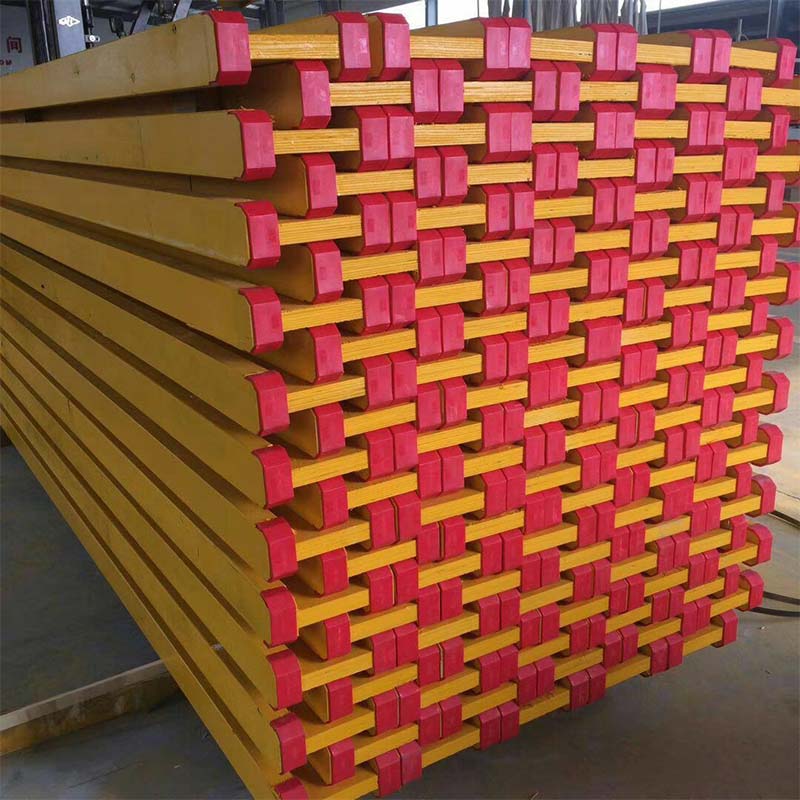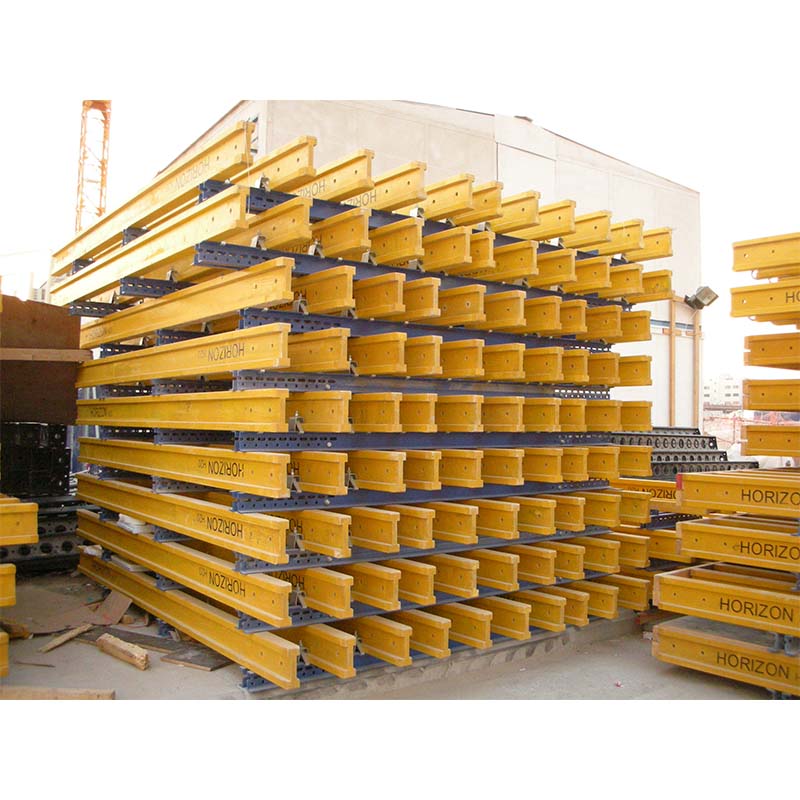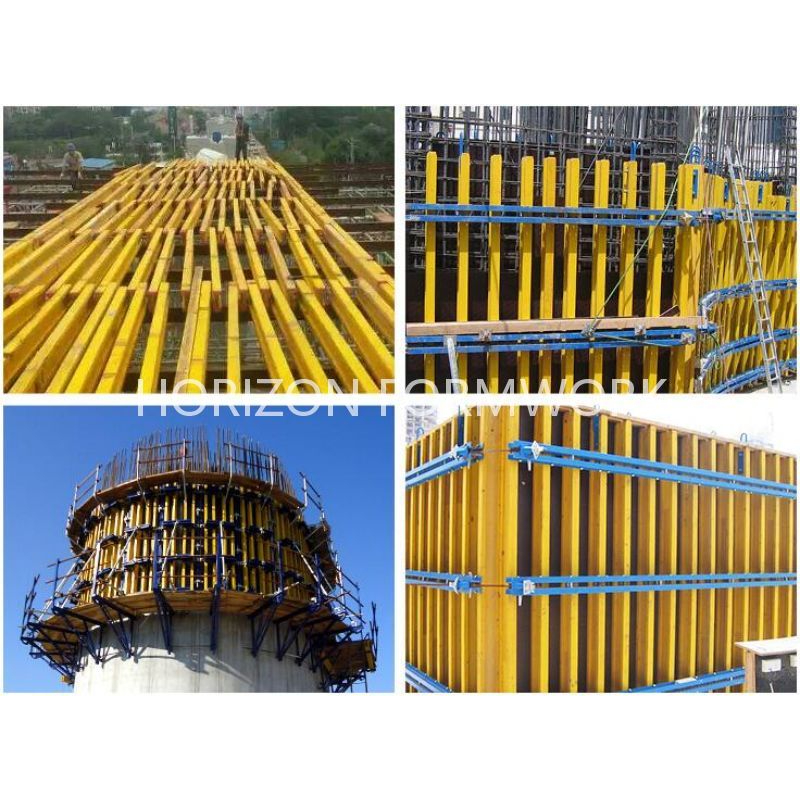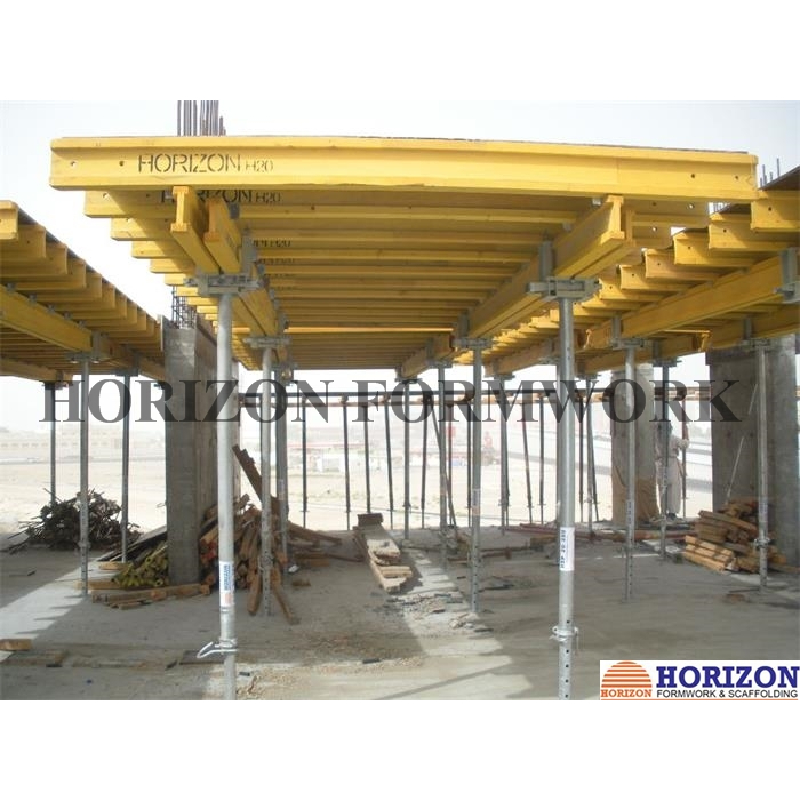ਅਗਃ . 15, 2025 01:20 Back to list
Premium H20 Timber Beam for Formwork & Slab Shuttering
Advancing Construction Efficiency: The Critical Role of H20 Timber Beams
In modern construction, the demand for robust, reusable, and efficient formwork solutions is paramount. Among the core components that meet these rigorous standards, the timber beam h20 stands out as an indispensable element. This engineered wood product is specifically designed to provide superior load-bearing capacity and dimensional stability, making it ideal for various concrete formwork applications. Its distinct H-shaped cross-section, characterized by high-grade flanges and a robust web, allows for optimized structural performance. As global construction projects become increasingly complex and deadlines tighten, the inherent advantages of high-quality H20 timber beams — including their lightweight nature, ease of handling, and exceptional durability — contribute significantly to on-site productivity and safety. This section will explore the industry trends propelling its adoption, from the increasing focus on sustainable construction practices to the imperative for cost-effective and reliable building materials.
The market for formwork components is currently experiencing a surge driven by urban development, infrastructure expansion, and a global emphasis on rapid construction techniques. The use of advanced materials and standardized components, such as the H20 timber beam, reduces material waste and labor costs while enhancing structural integrity. Furthermore, the rising awareness of environmental impact has pushed manufacturers to adopt more sustainable sourcing and production processes for timber-based products. This trend highlights the importance of selecting a reliable timber beam formwork manufacturer who adheres to strict environmental and quality standards. As a result, professional contractors and engineering firms are increasingly prioritizing suppliers capable of providing not only high-performance H20 timber beams but also comprehensive technical support and timely delivery to meet project timelines effectively.
Precision Engineering: Understanding the H20 Timber Beam Manufacturing Process
The production of a high-quality timber beam h20 is a sophisticated process that combines engineering precision with material science. The primary material typically consists of high-grade softwood, such as spruce or pine, selected for its strength and straight grain. The manufacturing begins with the careful selection and sorting of timber lamellae, which are then finger-jointed and glued under high pressure to form the continuous top and bottom flanges. These flanges, which bear the majority of the bending stress, are precisely dimensioned to ensure uniform strength along the beam's length. The web, the vertical part of the 'H' section, is often made from a high-density plywood or engineered wood product, which resists shear forces. This composite structure provides excellent stability and load-bearing capacity while keeping the beam relatively lightweight.

Image: Overview of the manufacturing process for H20 Timber Beams, emphasizing material integration and quality control.
Throughout the manufacturing process, strict quality control and detection standards are rigorously applied. Key standards like EN 13377 (European standard for prefabricated timber formwork beams) and ISO 9001 (Quality Management Systems) are routinely followed to ensure product consistency and reliability. Testing involves evaluating the beam's bending strength, shear resistance, and moisture content. The precise CNC machining ensures consistent dimensions and tight tolerances, which are critical for seamless integration into formwork systems. A well-manufactured h20 timber beam for shuttering boasts an impressive service life, often allowing for 80-100 reuses under proper handling and maintenance. This extended lifespan significantly reduces per-use costs, contributing to overall project economy and making it a preferred choice in the construction industry, particularly for high-rise buildings and complex concrete structures where reliability and reusability are paramount.
Technical Specifications and Performance Parameters of H20 Timber Beams
Understanding the technical parameters of an h20 timber beam is essential for engineers and project managers to ensure safe and efficient formwork design. The "H20" designation refers to its specific dimensions and structural properties, with a typical height of 20 cm. These beams are engineered to withstand significant bending moments and shear forces, which are critical in supporting wet concrete loads. The core strength comes from the quality of the timber used for the flanges and the robust bonding with the web. Critical parameters include its linear weight, typically around 5 kg/meter, which contributes to its ease of handling, and its bending moment resistance (Mmax) and shear force resistance (Qmax). These values dictate the spacing of the beams and the maximum load they can support, ensuring structural integrity during the concrete curing phase.

Image: Cross-section detailing the key dimensions and material composition of an H20 Timber Beam.
The following table summarizes typical specifications for a standard H20 timber beam, providing a quick reference for its design capabilities. These values are derived from extensive testing and adhere to international construction standards, guaranteeing reliable performance. The beam's robust design contributes to its exceptional reusability, a significant economic and environmental benefit on large-scale projects.
| Parameter | Value | Description |
|---|---|---|
| Beam Height (H) | 200 mm | Standard height defining the "H20" classification. |
| Flange Width (B) | 80 mm | Width of the top and bottom chord (flanges). |
| Web Thickness | 27-30 mm | Thickness of the plywood/engineered wood web. |
| Weight (per linear meter) | ~5.0 kg/m | Lightweight for easy handling and installation. |
| Bending Moment (Mmax) | 5.0 kNm | Maximum permissible bending moment. |
| Shear Force (Qmax) | 11.0 kN | Maximum permissible shear force. |
| Modulus of Elasticity (E) | ~10,000 N/mm² | Indicates stiffness and deflection performance. |
| Available Lengths | 1.95m to 5.90m (or custom) | Standard lengths and custom options for flexibility. |
Versatile Applications of H20 Timber Beam in Formwork Systems
The versatility of the h20 timber beam makes it a staple in various formwork applications across the construction industry. Its primary use is in supporting concrete slabs, where it forms the primary or secondary beam for horizontal formwork. For instance, in slab formwork, H20 beams are laid perpendicular to adjustable steel props, creating a sturdy grid onto which plywood panels are placed. This setup allows for precise leveling and efficient concrete pouring, minimizing deflection and ensuring a smooth, level slab finish. The lightweight nature of the beams compared to steel alternatives simplifies handling and installation, reducing labor requirements and accelerating project timelines significantly.

Image: H20 Timber Beams in action, demonstrating their critical role in slab formwork support.
Beyond slabs, the timber beam h20 formwork is also extensively used in wall and column formwork systems. In vertical applications, these beams serve as horizontal walers or vertical soldiers, reinforcing the formwork panels to withstand the lateral pressure exerted by fresh concrete. Their consistent dimensions ensure uniform concrete thickness and straight walls, contributing to the structural integrity and aesthetic quality of the final construction. The robust design and high load capacity of these beams make them suitable for diverse construction projects, from residential buildings and commercial complexes to large-scale infrastructure developments such as bridges and tunnels. A reliable formwork h20 timber beam supplier ensures that these beams meet specific project requirements, offering various lengths and customizable options to fit unique structural designs and construction methodologies.
Key Advantages of H20 Timber Beam Formwork in Modern Construction
The adoption of H20 timber beam formwork offers a multitude of advantages that directly translate into improved project efficiency, cost-effectiveness, and overall safety. Firstly, their lightweight nature significantly simplifies transportation, handling, and erection on job sites. This ease of maneuverability reduces the need for heavy lifting equipment, thereby lowering operational costs and minimizing the risk of on-site injuries. Secondly, the high load-bearing capacity combined with impressive dimensional stability ensures reliable support for concrete, minimizing deflection and contributing to the precise alignment of structural elements. This consistency is crucial for meeting stringent engineering specifications and achieving high-quality concrete finishes.
Furthermore, the exceptional reusability of a well-maintained timber beam h20 is a major economic benefit. With proper care, these beams can be reused dozens of times, drastically reducing material procurement costs over the lifespan of a project or across multiple projects. This reusability also aligns with sustainable construction practices, reducing waste and the environmental footprint of building activities. The integration of H20 timber beams into modular formwork systems allows for rapid assembly and dismantling, which directly contributes to faster cycle times for concrete pouring and overall project acceleration. This efficiency is critical for meeting tight construction schedules and delivering projects on time and within budget, making the timber beam formwork manufacturer a key partner in modern building endeavors.
Navigating the Market: Manufacturer and Supplier Comparison for H20 Timber Beams
When sourcing timber beam h20, selecting the right manufacturer or supplier is crucial for ensuring product quality, reliability, and project success. The market features numerous providers, from local distributors to large-scale china h20 timber beam for shuttering manufacturers with global reach. Key differentiating factors include the quality of raw materials, adherence to international manufacturing standards (such as EN 13377, ISO 9001), available product range (lengths, custom options), and post-sales support, including technical assistance and delivery logistics. Reputable formwork h20 timber beam manufacturers often provide detailed technical data sheets, test certificates, and boast a track record of successful project collaborations.

Image: A glimpse into a modern H20 timber beam production facility, highlighting mass production capabilities and quality control.
The table below provides a conceptual comparison of different types of timber beam formwork suppliers, emphasizing the aspects a B2B buyer should consider. While some specialize as a dedicated h20 timber beam manufacturer, others might offer a broader range of formwork components. Evaluating factors such as production capacity, quality assurance protocols, lead times, and customization capabilities will help procurement teams make informed decisions tailored to their project's specific demands and scale.
| Supplier Type | Key Characteristics | Advantages | Considerations |
|---|---|---|---|
| Direct Manufacturer (e.g., HorizonForm) | Owns production, R&D, and quality control. | Best pricing, custom solutions, direct quality assurance, strong technical support. | Minimum order quantities might be higher. |
| Wholesale Distributor | Stocks various brands, regional warehouses. | Quicker delivery for standard items, diverse product options. | Less control over manufacturing quality, potentially higher costs. |
| Import/Export Company | Sources from international manufacturers (e.g., China). | Competitive pricing for bulk orders, access to global supply chains. | Longer lead times, potential for varying quality control across sources. |
Customization and Global Supply Chain Excellence
In large-scale or specialized construction projects, off-the-shelf solutions may not always suffice. This is where the ability of a formwork h20 timber beam manufacturer to offer customized solutions becomes invaluable. Customization can involve specific beam lengths to minimize cutting on-site, pre-drilled holes for specific connection types, or even specialized protective coatings for extended durability in harsh environments. A manufacturer adept at customization can significantly reduce labor time and material waste on complex projects, leading to substantial cost savings and improved project precision.

Image: Global logistics network ensuring timely delivery of H20 Timber Beams to diverse construction sites worldwide.
For international projects, the efficiency of the supply chain is as critical as the quality of the product itself. Reputable timber beam formwork manufacturers possess robust logistics capabilities, ensuring timely and secure delivery of china timber beam h20 formwork to construction sites worldwide. This includes efficient packaging to prevent damage during transit, optimized shipping routes, and adherence to international customs regulations. A strong global distribution network minimizes delays, keeping projects on schedule and budgets intact, reinforcing the trust clients place in their chosen formwork partner. HorizonForm, as a leading timber beam formwork company, exemplifies this commitment by offering flexible customization options and reliable global supply chain management.
Success Stories: H20 Timber Beam in Action (Application Cases & Experience)
The practical effectiveness of the timber beam h20 is best demonstrated through its successful implementation in diverse construction projects globally. For instance, in a large-scale commercial high-rise development in Dubai, our formwork h20 timber beam suppliers provided over 50,000 linear meters of H20 beams for the complex slab and column formwork. The project team reported a 15% reduction in formwork assembly time compared to conventional systems, primarily due to the beams' lightweight nature and consistent dimensions, which facilitated rapid installation and dismantling cycles. This efficiency directly contributed to the project being completed ahead of schedule, showcasing the real-world impact of reliable materials.
Another notable case involved a major infrastructure project in Southeast Asia, where challenging climatic conditions demanded highly durable and reusable formwork. The project utilized specialized timber beam h20 formwork, treated for enhanced moisture resistance, demonstrating exceptional performance over multiple reuse cycles. Client feedback consistently highlighted the beams' structural integrity and minimal deflection under heavy concrete loads, which was critical for achieving the high-quality finish required for bridge decks and elevated road sections. These examples underscore the versatility and robustness of H20 timber beams, proving their value in diverse and demanding construction environments, and establishing leading timber beam formwork manufacturers as crucial partners for complex engineering feats.
Ensuring Trust: Quality Assurance, Support, and FAQs
Building trust with B2B clients in the construction sector hinges on unwavering commitment to quality and comprehensive support. A reputable h20 timber beam manufacturer will back their products with stringent quality assurance protocols, including adherence to international standards like ISO 9001 and specific timber product certifications (e.g., FSC for sustainable sourcing, if applicable). This includes rigorous testing for bending strength, shear capacity, and moisture content before dispatch. Furthermore, a transparent delivery cycle explanation, outlining lead times, shipping options, and estimated arrival, builds confidence, especially for large, time-sensitive projects.
Warranty commitments and dedicated customer support channels are equally vital. A solid warranty ensures product performance and offers recourse in rare instances of manufacturing defects. Technical support, including engineering guidance on formwork design and best practices for beam usage and maintenance, helps clients optimize product performance and extend lifespan. Below are some frequently asked questions that address common concerns about timber beam h20, further enhancing trustworthiness.
Frequently Asked Questions (FAQs)
Q: What is the typical lifespan of an H20 Timber Beam?
A: With proper handling, storage, and maintenance, an H20 timber beam can typically be reused 80-100 times, making it a highly cost-effective formwork solution. This reusability depends on factors like site conditions and care during striking.
Q: Are H20 Timber Beams suitable for heavy-duty concrete structures?
A: Yes, H20 timber beams are engineered for high load-bearing capacity, making them suitable for supporting heavy concrete loads in various structures, including slabs, columns, and walls. Their specified bending and shear capacities are designed for such applications.
Q: Can I get customized lengths for H20 Timber Beams?
A: Many reputable timber beam formwork manufacturers, including HorizonForm, offer custom length options to minimize waste and optimize efficiency on your project site. It's best to discuss your specific requirements with the supplier.
Q: What environmental certifications should I look for?
A: For environmentally conscious projects, look for H20 timber beams with certifications like FSC (Forest Stewardship Council) or PEFC (Programme for the Endorsement of Forest Certification), which ensure sustainable forest management.
Conclusion: Partnering for Formwork Excellence
The timber beam h20 remains a cornerstone in modern concrete formwork, offering an unparalleled combination of strength, lightweight design, and reusability. Its meticulous manufacturing process, adherence to rigorous technical standards, and versatile applications underscore its importance across the construction spectrum. From enhancing project efficiency and reducing labor costs to contributing to sustainable building practices, the advantages of integrating high-quality H20 timber beams into formwork systems are clear. Choosing a reliable timber beam formwork company that prioritizes product quality, provides comprehensive technical support, and offers efficient global logistics is paramount for engineering and construction firms aiming for excellence in their projects. By leveraging the proven capabilities of the H20 timber beam, construction professionals can ensure the timely, cost-effective, and high-quality completion of their most ambitious endeavors.
References
- EN 13377: Prefabricated timber formwork beams – Requirements, classification and assessment. European Committee for Standardization.
- ISO 9001: Quality management systems – Requirements. International Organization for Standardization.
- Forest Stewardship Council (FSC) Certification Standards for Forest Management.
- Portland Cement Association (PCA) publications on Concrete Formwork Design and Construction.
This is the last article
-
Premium H20 Timber Beam for Formwork & Slab Shuttering
NewsAug.15,2025
-
China Single Sided Wall Formwork: Fast, Flexible Solutions
NewsAug.14,2025
-
Scaffolding Jacks: Durable Screw, U-Head, Swivel & Base Jacks
NewsAug.13,2025
-
Reliable China Single Sided Wall Formwork Manufacturer
NewsAug.12,2025
-
Formwork Wing Nut | Quality Tie Rod & Water Stop Supplier
NewsAug.11,2025
-
Durable Steel Prop with Tripod for Stable Support
NewsAug.10,2025